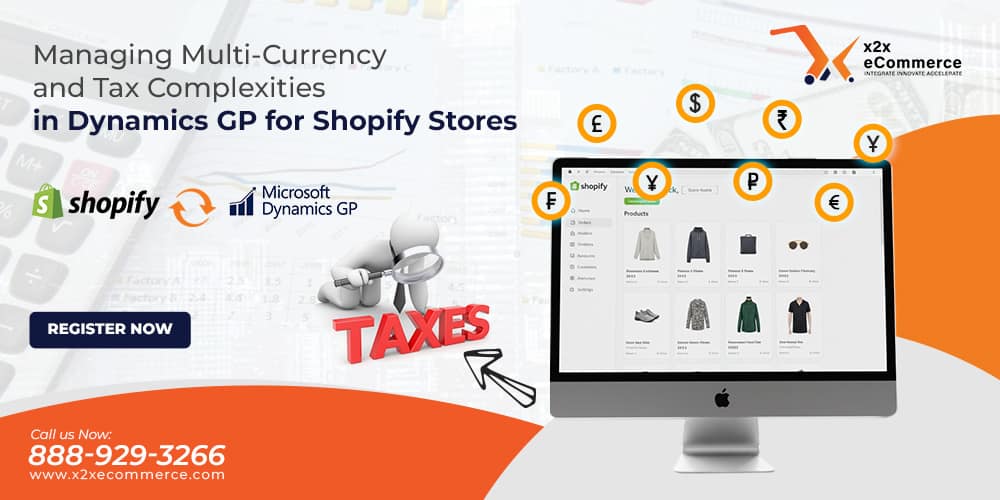
Introduction
For international Shopify store owners, aligning disparate currencies and complicated tax laws can be an administrative headache particularly when working with legacy ERP solutions such as Microsoft Dynamics GP. While GP is a sound finance platform for most companies, it was not created with eCommerce agility in focus during its early stages of development.
To stay in business, back-office accountants GPs and e-shops need a simple way of processing foreign exchange, exchange rates, and local tax in different places. This blog explains how to handle these issues and synchronize your data between GP and Shopify.
1. The Challenge: Global Commerce Meets Local Compliance
Multi-Currency Transactions
Customers must buy and pay in their local currency. GP also has an account in a home currency, which must be converted on every transaction.
Multi-Jurisdiction Tax Laws
Tax exempt, tax rates, and tax reporting vary by country (and, in a few instances, state or province). Manual VAT, GST, HST, or sales tax is time consuming and prone to errors.
Disintegration makes finance teams have to contend with variance in data, reconciliation, and compliance risk.
2. Dynamics GP Strengths and Weaknesses
Currency Module
- Reporting and functional currency support.
- Based on manually updated or batch-updated exchange rates.
- Not automatically overridden by Shopify currency conversions.
Tax Module
- Basic sales tax and VAT setup support.
- No cross border e-sales or jurisdiction-based tax adjustment automation.
- No third-party tax engines or Shopify real-time tax calculation realism.
- Create lack in ERP records vs. online revenue due to lack of this feature.
3. Shopify Strength: Real-Time Currency and Tax Calculations
Shopify makes buying easier by making it more convenient through dynamic management of:
- Real-time exchange rate conversions to the customer’s location.
- Localized taxation laws applied automatically by Shopify’s tax engine or third-party vendors (e.g., Avalara or TaxJar).
- Checkout fees made transparent to make consumers understand the total charged.
But unless highly integrated, these Shopify values hardly translate directly onto GP’s books of accounts.
4. Bridging the Gap: Best Practices for Integration
a. Utilize a Specialized GP-Shopify Integration Connector
Current integration products or custom APIs offer auto sync for:
- Shopify payments/orders → GP
- Currency and tax values to GP fields
- Daily exchange rate refreshed through currency feed APIs
b. Map Functional vs. Reporting Currencies Effectively
Make sure:
- Shopify transaction currency = Customer currency in GP.
- Exchange rate = Auto refreshed or fetched daily.
- Reporting currency = Company home currency in GP for financial consolidation.
c. Automate Tax Code Mapping
Use tax mapping rules as indicated below:
- Shopify tax codes (country, state, or region) map to GP tax schedules.
- Tax-inclusive Shopify orders are properly converted to GP line-item format.
- GP tax liability accounts properly reflect jurisdiction totals for reporting compliance.
d. Leverage Third-Party Tax Engines
If your business is selling globally, third-party software such as Avalara AvaTax or Vertex can connect with Shopify and GP to automate tax determination, calculation, and filing.
5. Major Advantages of Seamless Integration
Seamless integration of tax and multi-currency data provides businesses:
- Correct Financial Reporting – Exchange discrepancy loss eliminated with real-time currency conversion.
- Regulations Compliance – Lower audit risk for tax automation rules.
- Quicker Month-End Closings – No reconciliation manually between Shopify orders and GP journals.
- Better Customer Experience – Correct price and tax displayed to customers, fewer disputes and refunds.
Conclusion
Aside from manual exportation, cross-tax and currency management between Shopify and Dynamics GP calls for intelligent integration. Automated data, tax code, and third-party tax engine synchronization can offer solid financials and remain region friendly.
In the age of global trade, all ERP and e-Commerce integrations are not only a luxury but an absolute need to provide fiscal precision and business growth.





